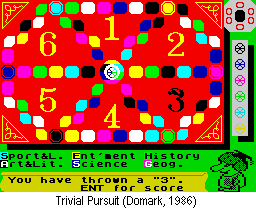|

By Lloyd Mangram
October
1986
Issue 33
|
|
October's
cover marked a departure from the previous 32 covers;
for the first time in the CRASH history it was painted
by a hand other than Oliver Frey's, that of Ian Craig.
It was not designed with any particular game in mind,
but did have a passing resemblance to (and was a visual
pun on) Oliver's very first CRASH cover. For the savage
face, Ian used a photograph of a friend, though the
pointed ears and sharp fangs were invented. As Oliver
does with many pictures, Ian used an airbrush and then
overpainted with an ordinary brush.
|
Early in September most of the editorial and mail-order staff
decamped to London's Olympia for the ninth PCW Show. It was
the year of the infamous sticker campaign, when C&VG plastered
the Newsfield stand with Melissa Ravenflame adhesive labels,
and Newsfield retaliated with some Hannah Smith stickers printed
at the last moment. At one point, Commodore User editor Eugene
Lacy returned to the EMAP stand's office and could no longer
find the door - Mike Dunn and Ben Stone had hidden it under
literally hundreds of stickers.
 It
was also the moment when Gargoyle Games underwent a metamorphosis
and became Faster Than Light. Apart from the excitement of
their own two games, Lightforce and Shockway Rider,
they had a hit on their hands for Elite with the much-delayed
Scooby Doo. Elite were riding high: after a disappointing
Commodore 64 conversion of the coin-op Paper Boy, it
only just missed a CRASH Smash on the Spectrum, though the
Capcom conversion 1941 did far less well. Domark followed
up the puzzles of Splitting Images with the official
version of Trivial Pursuit. Despite the many trivia
clones already out, the qualities of Domark's version shone
out, and it too received a Smash. We also thought highly of
Costa Panayi's Revolution, a 3-D puzzle-solving game which
earned Vortex yet another in their long line of Smashes. It
was also the moment when Gargoyle Games underwent a metamorphosis
and became Faster Than Light. Apart from the excitement of
their own two games, Lightforce and Shockway Rider,
they had a hit on their hands for Elite with the much-delayed
Scooby Doo. Elite were riding high: after a disappointing
Commodore 64 conversion of the coin-op Paper Boy, it
only just missed a CRASH Smash on the Spectrum, though the
Capcom conversion 1941 did far less well. Domark followed
up the puzzles of Splitting Images with the official
version of Trivial Pursuit. Despite the many trivia
clones already out, the qualities of Domark's version shone
out, and it too received a Smash. We also thought highly of
Costa Panayi's Revolution, a 3-D puzzle-solving game which
earned Vortex yet another in their long line of Smashes.
The biggest disappointment, though hardly a surprise, came
with Ocean's ludicrously delayed Knight Rider. Rumours from
within Ocean's offices had said it was a poor effort, and
it was.
Internally there were some sweeping changes. The new offices
opened, admin moved out, film planning moved down, LM moved
across for two weeks from its small room into what had been
advertising before finally departing to Gravel Hill, CRASH
moved upstairs to where LM had been and Cameron Pound's photographic
empire gained the room CRASH had just vacated. It was a bit
like playing Splitting Images.
Graeme Kidd waved a goodbye of sorts. At the very end of
August, shortly after CRASH's new Staff Writer Tony Flanagan
had decided to leave, Graeme himself resigned over administrative
problems. It was a difficult moment, with CRASH short-staffed
and LM starting up, so Graeme was offered a new job as Publishing
Executive in overall charge of the three computer magazines
- which he accepted. However, he would remain titular editor
of CRASH for a while yet. Meanwhile, Roger Kean had finally
relinquished the editorship of ZZAP! to Gary Penn, and moved
with the rest of LM to their new home in Gravel Hill. It was
a busy month.
And on top of that came news from the Audit Bureau Of Circulations
that CRASH was still the biggest-selling computer title in
Britain, outstripping all others at over 100,000 copies a
month. Roger Kean recalled a meeting in April 1984 with several
top people from the old Imagine in Liverpool, when someone
prophetically told him that CRASH was so different that it
was bound to sell over 100,000 a month soon. He had been pleased,
but seriously doubted CRASH would ever reach those sorts of
figures. Doing better than 50,000 would have been a thrill
for us in those early months.
At about the moment the October edition reached the printers,
LM was officially launched at a big party in London, where
the dummy was introduced to potential advertisers and Roger
Kean made a speech he had rehearsed for days. I hate parties,
I didn't go.
|